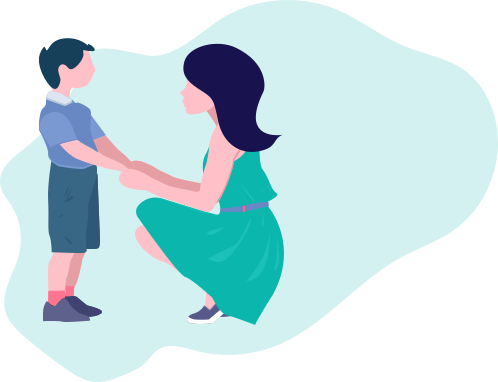

This section will cover how you can help your child manage difficult emotions or behaviours. Perhaps you may have identified some symptoms or behaviours after reflecting on your child’s symptoms.
The key thing is to ensure that your child is supported, has a safe space to be upset and display emotions within limits, and to reassure them that there is no current danger.
We will be covering how you can support your child through:
Explore the tabs below to learn about helping your child through these feelings and behaviours. Once you have finished reading, you can explore activities you can do at the bottom of the page.
For example, your child may have experienced a car accident and have a fear around crossing the road or getting into a car. Or they may seem ‘on edge’ or ‘on the lookout’.
Anxiety/feeling worry is a normal part of recovery from a scary incident.
After such experiences, the brain can interpret things connected to the event, or everyday triggers, as if they are directly related to the event.
Feeling on edge, afraid, or worried is the brain’s way of anticipating future danger and protecting one-self.
But worrying can be helpful or unhelpful.
Helpful: e.g., wearing a helmet whilst cycling, safely travelling and crossing the road, being aware of one’s surrounding.
Unhelpful: e.g., being very afraid of going to school, refusing to leave the house.
Your child may not even be aware that something has triggered a trauma-related fear, and emotions or feelings may seem as though have come on suddenly.
It is helpful to be patient with your child and comfort them.
The important things to remind your child are:
Whilst it is normal to want to keep your child safe, and it may be difficult to see them face their fears and feel upset the first few times, too much protection and avoidance of reminders can make it more difficult to get over feeling scared.
You can click on the image below to see some things to keep in mind and what you can say to your child:
Whilst ‘having a go’ at facing fears is the best thing for your child’s emotional recovery, there are techniques you can encourage in the moments when these emotions may be ‘bubbling up’ in.
Your child may experience some really intense physical symptoms, for example:
These symptoms can be really uncomfortable and can lead to more anxiety themselves. Children may think that is there is something physically wrong with them, or that something bad will actually happen.
It is important to acknowledge your child’s symptoms and remind your child that:
There are certain things which can help with these feelings. Let’s take a look at some.
Shifting your child’s focus away from the physical sensations can interrupt the cycle of fear where the physical feelings themselves may lead to further worries and be seen as confirmation of their fears.
If your child has difficulty shifting their focus, you can try a simple mindfulness technique called the 3-3-3 technique. Here, you can sit down with your child are name:
This can help shift focus away from any unpleasant fear-related feelings.
You can click on the image below to save it and keep as a handy reminder.
Relaxation techniques can also be helpful and gentle ways to help your child calm down if they are experiencing intense emotions or feelings.
Physical things which can help your child relax include:
A specific technique is ‘box breathing’, or 'square breathing'.
Find a quiet, safe space and try it together.
If they find their attention drifting – that is okay, you can encourage them to pull it back to their breath. This involves….
The ‘tense and relax’ method can also be helpful for physical sensations. This is a two-step process:
You can use different metaphors to help them understand (e.g., stand straight like uncooked spaghetti and floppy like cooked spaghetti), and move from scrunching eyes shut and down to tensing and wiggling toes.
If your child is thinking unhelpful thoughts (e.g., “I will never be normal again”, “The world is unsafe”), it is important to talk these through and rethink them. Thoughts are really important as they can affect how we feel and what we do.
The good news is that you can encourage your child to ‘talk back’ to the thought and question it.
We will cover rethinking unhelpful thoughts in session four.
Your reaction can affect how your child is feeling. This is because children are tuned into the reactions of their parents or other caregiving adults in their life.
So, it is important to be aware of your own worries, low mood, or difficult feelings.
Identifying these are the first important step, and then you can take steps to manage them. This can look like:
Taking care of your own worries is important to ease feelings of guilt you may be having, and to make sure that you are emotionally available to support and nurture your child.


Nightmares are normal after something frightening like an accident or injury has happened.
Your child may experience nightmares relating directly to the event including images or emotions, or they could be completely unrelated to what happened.
It is advised to not wake your child up during a nightmare – wait until it is over and then you can try waking them up.
When your child is awake:
You can read through the tabs below for some things you can do to help your child process the nightmare and how they feel afterwards.
Reassure your child that what they experienced was a bad dream which is now over, and that what happened isn’t real and they are safe.
For example: “That dream sounded very scary and it is normal to feel upset after something like that. But it is now over and you are safe."
This involves sitting down with your child and ‘putting the nightmare away’. This can involve writing it in a journal or on a piece of paper which is put away into a box.
Or, you could draw the nightmare and allow the child to rip it up so it no longer ‘exists’.
Change the scary images into something else.
For example, you can guide your child to:
This can help children have some control over their nightmares.
You can download a worksheet to draw the 'Dream TV' with your child.

Some children may display difficult feelings and behaviours (e.g., anger, tantrums, defiance).
This is a completely normal reaction after a scary experience.
Often, children may get angry, break rules, and have tantrums because they are scared, or they may not be able to communicate what they are feeling or thinking.
This can be difficult for you as a parent as there are two things to balance here:
Research has shown that effective parenting includes warmth and consistent parental control.
Firstly, make sure that the basics are covered.
These basic needs are really important when it comes to preventing difficult behaviours like angry outbursts or tantrums.
But, it is totally understandable if your child is experiencing some difficult and intense feelings after going through a scary experience. Research tells is that this is completely normal.
If all the basics are met and your child is still feeling angry, it is important to remain calm and compassionate. Try to understand where they are coming from, and be a soothing and safe presence.
For example, try these phrases:
When angry outburts happen, there are a few things you can do:
Tip: It can also be helpful to verbally praise them when they show feelings of self-control if they manage to overcome these feelings or behaviours in the future.
This can be really challenging. Children may lash out at others because something may be bothering them, or they are experiencing some overwhelming feelings.
Sometimes these intense behaviours can be calls for help.
In the moment, it is important not to overreact. Make sure to:
This could take a while and they may get angry, but it is important to remain calm. Your child should know that what they did was not okay, but they are in a safe space to talk through any feelings.
Time-out can be a useful tool if you use it correctly and consistently.
It can be a way to temporarily remove the child from the situation and the attention which may be making the feelings more intense.
But, it is important that time-out is not overused and that your child is aware of:
Situations when time-out can be used include:
However, this can be a tricky thing to do without proper guidance, especially after your child has experienced a scary event or injury. So, this should not be the first response if your child displays difficult behaviours.
Time-out should be used for specific behaviours and must be consistent.
Things to keep in mind:
After time-out, approach them calmly.
For example:
After time-out, make sure to verbally praise your child for positive behaviour (e.g., "Thank you so much for putting your toys away.")
This positive interaction promotes bonding and emotion regulation.
It is important that your child is aware that their actions have consequences. For example, if they throw a tantrum, make a mess, or upset someone else.
It can be helpful to have consequences for outbursts and difficult behaviours, but these should not be out of proportion to their behaviour and should be consistent.
For example:
There may be common 'tantrum triggers'. For example, being asked a question about what happened or going to school.
Whilst certain things like going to school cannot be avoided in the long-run parents and caregivers can help defuse the situation.
The first step is to anticipate the potential triggers.
This can look like giving your child more warning about a certain task, or structuring certain activities in ways that reduce the likelihood of a tantrum.
For example, giving a warning time before a task ends (e.g., “We’re leaving in 10 minutes” before leaving home).
For example, you could break down intimidating tasks into smaller chunks. You can reward your child for achieving this small 'wins' and for controlling their anger in small, manageable chunks of time.
Gradually, you can increase the time spans and broad the situations.
In this section, we learned about some strategies you can use if your child is feeling worried, feeling angry or behaving difficulty, and having nightmares. There are some simple techniques to:
Below are a couple of activities you can try to build a toolkit of the techniques we learned about, and how to process and move on from nightmares.
Please click on the links below to learn more about these techniques.